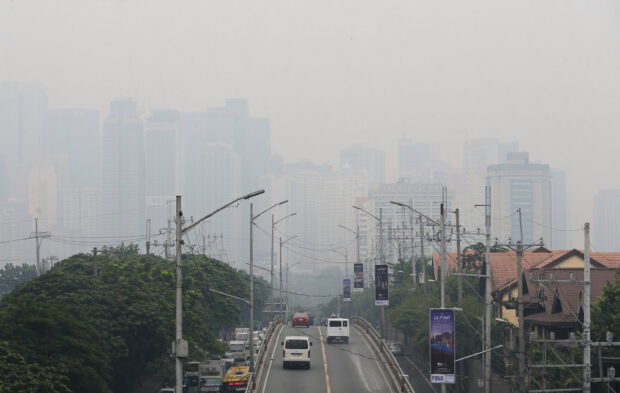It’s smog, not vog, in Metro Manila —but put masks back on

Authorities are now again urging the public in Metro Manila and nearby provinces to wear face masks, especially outdoors, due to smog and vog (air pollution from volcanic emissions) caused by the continued unrest of Taal Volcano.
But both the Philippine Institute of Volcanology and Seismology (Phivolcs) and the Environmental Management Bureau (EMB) clarified on Friday that the smog in Metro Manila was not caused by Taal, but, rather, by the air pollution in the metropolis, coupled with a natural phenomenon called “temperature inversion”—which basically traps smog and other particulate matter closer to the ground.“
The smog [in Metro Manila] is not related to Taal Volcano. Instead, the vog was over areas on the western side of Taal Volcano,” Phivolcs said.
The EMB, an agency of the Department of Environment and Natural Resources, said in a report on Friday: “Real-time air quality measurements indicate heightened alert in some parts of Metro Manila, primarily attributed to emissions from heavy vehicular traffic, especially during rush hour.”
Not related
The bureau also noted that Taal’s vog could not reach Metro Manila, as surface and upper winds were “coming from the northeast direction going to the southwest direction, or going away from Metro Manila.”
Science and Technology Secretary Renato Solidum Jr. also confirmed that the smog in the capital region was not the vog from Taal.
Nevertheless, he advised the public to wear masks when outside or, if possible, stay indoors.
But authorities could not categorically determine when the smog in Metro Manila would be cleared.
Air quality index
“Air quality varies in time and places and can change anytime depending on pollution sources and meteorological factors,” the EMB said.
The bureau’s report still noted the health risks of air pollution in the metropolis, specifically PM2.5 and other particulate matter, as detected in the southern cities of Parañaque and Makati and the municipality of Pateros.
PM2.5 are fine, inhalable particles with diameters that are generally 2.5 micrometers, or 30 times larger than the diameter of a hair strand.
Short-term exposures to PM2.5 (up to 24-hour duration) have been associated with premature mortality, increased hospital admissions for heart or lung causes, acute and chronic bronchitis, and asthma attacks.
These adverse health effects have been reported primarily among infants, children, and older adults with preexisting heart or lung diseases.
Parañaque registered an air quality index (AQI) of 217—classified as the fifth in a six-tier air quality guide—which is considered “acutely unhealthy.” Lower numbers means better air quality.
Under this category, people are advised to limit going outdoors, especially those with heart or respiratory diseases.
Makati and Pateros were monitored as having 128 and 141 AQI, respectively—both considered “unhealthy for sensitive groups.”
DepEd order
Amid the poor air quality, only six of the 17 local government units in Metro Manila—Las Piñas, Muntinlupa, Parañaque, Pasay, San Juan and Valenzuela—canceled classes early on Friday. The rest in the National Capital Region suspended afternoon classes.
Sought for comment, Education Assistant Secretary Francis Cesar Bringas said school heads should follow Department Order No. 37, series of 2022, on the cancellation or suspension of classes and work in the event of natural disasters, power outages and other calamities.
From northeast
While DO 37 has no provision on such phenomena as the presence of smog, Bringas said a memorandum he signed in April gives school heads the “authority and responsibility” to suspend classes.
This includes events “which may considerably affect the conduct of classroom learning and put the learners’ health and well-being at risk.”
The memo was issued at the time when schools needed to suspend classes due to extremely high temperatures in the country, which was previously not listed as among valid grounds for the suspension or cancellation of classes.